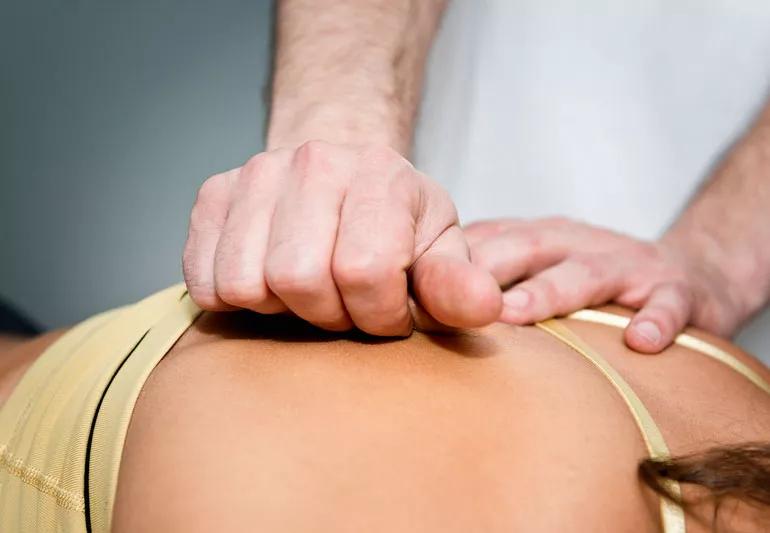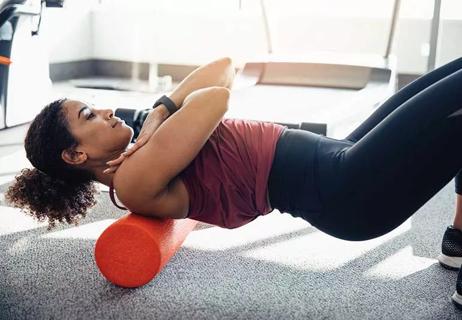Use this hands-on approach to manage pain and discomfort

Does your body always feel tight or sore? Are your neck, shoulders, back and even your head screaming for relief? If you’ve been looking for ways to ease the pain, myofascial release might be the answer.
Advertisement
Cleveland Clinic is a non-profit academic medical center. Advertising on our site helps support our mission. We do not endorse non-Cleveland Clinic products or services. Policy
Myo what?!?
We promise it’s totally legit. If you’ve never heard of it, let’s start with the basics.
“‘Myo’ is the shortened word for muscular tissue. ‘Fascia’ is a three-dimensional web of connective tissue that goes from the very superficial layers of muscular tissue to the very deep layers and all the way down to the bone,” says chiropractor Chad Adams, DC.
He describes it as part of the body’s scaffolding.
“It gives our bodies levers and fulcrums so we can move,” he says. “If part of that system is compromised, we get less range of motion and less of an exchange of nutrition for the joints. We also increase our sensitivity to pain and increase our susceptibility to early onset of degeneration.”
So, that tight neck or those frequent muscle spasms could lead to substantial and dangerous conditions like stenosis down the road.
Dr. Adams explains how myofascial works and techniques to try.
Myofascial release (not myofascial release) is a hands-on approach to managing pain and discomfort.
Now, don’t expect a gentle massage with aromatherapy and pan flute music. Instead, myofascial release can be an intense experience.
During a myofascial massage session, a physical therapist, chiropractor or even massage therapist will massage, knead and gently stretch your muscles and fascia to work out knots.
Advertisement
Myofascial therapy also involves applying pressure to tight or sore areas to get them to relax. The pressure is applied with the therapist’s hands, elbows or a massage tool like a foam roller or a ball. You might feel sore afterward, but when the soreness subsides, you’ll feel a lot looser than you did before.
It’s really good for parts of the body that are used a lot or in fixed positions for a long time. These areas include your:
In order to ease tightness or pain during a myofascial release, you’re going to have to find the source. Dr. Adams recommends finding spots that are very tender and staying there for as long as it takes for those spots to release or loosen up. That time could be anywhere from two to five minutes.
“People will just jump on top of a foam roller, roll around for a couple of seconds and think they’ve gotten everything,” explains Dr. Adams. “But it really takes time and intention. So, when you find a place that has some tension or tightness, or it feels like, Oh my gosh, that’s the spot, stay there. You might have found the epicenter. And you might discover that the other spots around it will actually release or ease up after you’ve addressed the main problem.”
Myofascial release can help if neck pain or tightness and headaches are getting the best of you. With a few simple myofascial release techniques, you can ease the tension away right at home.
For pain that runs down one side of your neck:
For neck pain you can pinpoint:
And if you’ve been carrying the weight of the world on your shoulders and need some relief, try these techniques for shoulder pain:
For pain that starts at your shoulder and travels down your arm:
For shoulder pain you can pinpoint:
Advertisement
Myofascial release is not a competitive sport. You have nothing to prove to anyone and it isn’t about how much pain you can stand before you pass out. Instead of going all-in with the strongest tool you can find, start with something like a tennis ball and use it to gently roll out your muscles or to apply pressure to tight spots.
If you don’t feel like the pressure is enough, try using a lacrosse ball. You can experiment and adjust accordingly. Whatever you do, don’t burn your money on expensive massage gadgets. Dr. Adams says you can get major relief from items that are less than $20.
When done regularly, you can:
If you feel sharp, shooting pain that doesn’t ease up while doing myofascial release at home, stop. At that point, contact a professional.
You’ll also want to avoid doing it if you’re on blood thinners or have the following:
Advertisement
Myofascial release isn’t the kind of thing that you can do casually. Dr. Adams emphasizes that if you want the results to last, you have to do it every day.
“I do something every day whether I have pain or not. I scan every single joint of my body in as little as five minutes,” he says. “And if I find that I have a couple of areas that are problematic, that’s what I focus on for that particular day.”
You might get started at home and think that you’re not really making a difference, but Dr. Adams stresses that it’s important to keep your routine going.
“My biggest recommendation is to be consistent, even if it’s only a couple of minutes a day,” he says. “It will make a drastic difference in the long term.”
Dr. Adams advises that if you sense something is wrong or your pain isn’t getting any better, talk to a healthcare provider.
“You have to trust your intuition,” he says. “For example, if it’s a chronic shoulder injury and you’ve tried a couple of things and nothing’s improved, you need to seek out a professional.”
Advertisement
Learn more about our editorial process.
Advertisement

This self-myofascial release technique can help ease sore or achy muscles

Breathing, exercise, mindfulness and more can help you unwind and step away from your stress

Move a little more, eat a little healthier, sleep a little better and destress a lot

Spinal blocks provide complete numbing for shorter periods, while epidurals can allow for some feeling

From breath meditation to yoga nidra, all types of meditation aim to help you feel calmer, more relaxed and present

This fruit has clear nutritional benefits — but there’s little evidence it can prevent or treat illness

Until there’s more research on it, this plant’s greatest claim to fame is its deliciousness

Hot tub sessions can help relieve stress, soothe sore muscles and improve heart health

Start having sex about 72 hours before ovulation, then at least every other day during your fertile window

Attachment theory suggests that your earliest relationships shape connections throughout your life

It isn’t a recognized mental health disorder, but research shows that problematic social media use can negatively affect your mental health, self-esteem and sleep